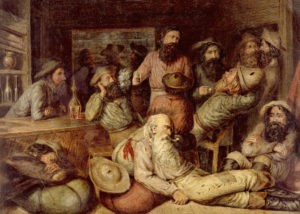Editor’s note: In 1858, just nine years after California was flooded with prospectors chasing their fortune, gold was discovered on the Fraser River. It’s not as well known, but what followed was no less significant or transformative than the California Gold Rush – and the disaster that almost happened may well have placed Canada, British Columbia, and North America on a very different course.
The following is an excerpt from Claiming the Land: British Columbia and the Making of a new El Dorado.
American miners, by practising lynch law, vigilantism, and forming militias north of the border, had not only taken the law into their own hands, but had done so in a foreign land. As the fur trader Jason Allard put it: “Agitations were started to clean up the Indians. . . . * The irregular troops started for vengeance, in military formation, the stars and stripes at their head.”
As miners evacuated the Upper River country and returned to Yale for safety, the Victoria Gazette reported the first in a series of armed companies that were bent on making war.
Captain Charles Rouse, an old Texas Ranger, with the assistance of his volunteer soldiers, “route[d] the Indians [near Spuzzum], who took refuge in the mountains; they then burnt three of their rancheries [villages], destroying all of their provisions, which consisted of salmon and dried berries. The miners found quite a number of packages of powder and lead in the different camps. There have been, in all, five of their rancheries burnt; three above the Big Canon, and two below.”
Rouse returned to Yale, just twelve miles below the scene of the action, “having in custody an Indian Chief [Kowpelst] . . . and the crowd were for lynching the Indian first and inquiring what he had done afterward.”

While white miners claimed that they had killed nine Natives including a chief during the conflict, it was later confirmed “from the Indians themselves” that in fact 31 Natives and an additional five chiefs had been massacred. The general excitement among foreign gold seekers grew to crisis level as all-out war appeared to be imminent.
Before news reached Yale of Rouse’s campaign of reprisal, a mass meeting of several thousand miners was held to organize against the Indigenous peoples. Captain George Wesley Beam, writing from Puget’s Sound Bar on 18 August 1858, recorded in his diary that “some of the White men are frightened to death. They think there [sic] day has come and they are not ready to go.”
Just three days later Beam further penned in his diary that “at Union Bar they got five men out of the River that was shot by the Indians. They had their heads cut off.”
Certain reminiscences have tended to sensationalize the number of foreign gold seekers who were found decapitated, but at the same time there is considerable evidence among contemporary letters, diaries, and newspaper accounts that numbers of such instances occurred.
This point is worth making only because historians have tended, until recently, to discount these reports. The evidence accumulated here suggests otherwise. Suffice it to say, as English miner Radcliffe Quine wrote of the conflict to his brother, “[They] declared war aginst [sic] the whites but we some put and [sic] end to it, but many hundred lives lost.”
Foreign miners were being driven from the upper reaches of the Fraser and Thompson diggings, beaten back to Spuzzum where they briefly congregated, hurriedly burying their canoes filled with provisions, before scrambling over the Douglas Portage to the safe haven of Fort Yale.
With the arrival of so many hapless miners beating a retreat to forts Hope and Yale, public meetings were called that served to incite the miners to further arm and organize against Indigenous peoples.
Locally, retribution was immediate with non-Natives disarming at gunpoint the Native village next to Fort Yale, appropriating the weapons for their own use in the war. Yet it was beyond Fort Yale where considerable numbers of Indigenous peoples were killed at points all along the Fraser and Thompson rivers.
*For accuracy, the term “Indian” has been preserved in quotations.
A fifth-generation British Columbian, Daniel Marshall is an author, professor, curator, documentarian, and researcher focusing on British Columbia’s relatively untold but rich history. He is a recognized leader and award-winning researcher on historic Native-Newcomer relations, and their evolution and implications on Aboriginal rights today.
His award-winning documentary, Canyon War: The Untold Story, has aired on Knowledge Network, APTN, and PBS. His latest book, Claiming the Land: British Columbia and the Making of a New Dorado, is available in bookstores across B.C.


